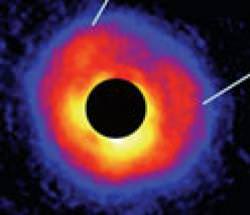One of the biggest unresolved questions of planet formation is how a thick disc of debris and gas surrounding young stars eventually evolves into a thin, dusty region with planets. This entire process, of course, has never actually been observed. But recently, and for the first time, a group of astrophysicists produced an image of material surrounding a star which seems to be coalescing into a planet.
The image was produced from a coronagraph attached to a telescope in Hawaii. It shows a horseshoe-shaped void in the disc of materials surrounding the star AB Aurigae, with a bright point appearing as a dot in the void.
“The deficit of material could be due to a planet forming and sucking material onto it, coalescing into a small point in the image and clearing material in the immediate surroundings,” said researcher Ben Oppenheimer, an astrophysicist at the American Museum of Natural History in New York. “It seems to be indicative of the formation of a small body, either a planet or a brown dwarf.”
A brown dwarf is considered a star that’s not massive enough to generate the thermonuclear fusion to create an actual star.
From what we know about planet formation, planets seem to be natural by-product of stars. But how does all this happen? Stars form when clouds of gas and dust contract under gravity, and if there’s enough compression and heat, sooner or later a nuclear reaction is triggered, and voilà : a star. If there’s any left-over material surrounding the young star, eventually the disc of dust and/or gas may congeal into planets. But the details of this process are unknown.
AB Aurigae is a well-studied star. It’s young, between one and three million years old, and can provide information on how stars and objects that orbit them form. And scientists hope that by studying this star, we can learn more about how planets form from the initial thick, gas-rich disk of debris that surrounds young stars. The observation of stars slightly older than AB Aurigae shows that at some point the gas is removed, but no one knows how this happens. AB Aurigae could be in an intermediate stage, where the gas is being cleared out from the center, leaving mainly dust behind.
“More detailed observations of this star can help solve questions about how some planets form, and can possibly test competing theories,” says Oppenheimer. And if this object is a brown dwarf, our understanding of them must be revamped as brown dwarfs are not believed to form in circumstellar materials, Oppenheimer said.
Original New Source: National Science Foundation Press Release


Two observations about the picture shown above: There seems to be material accumulating at the Trojan points 60 degrees in front and behind the orbit of the suspect.
There are other suspect clearings in disc at 10, 7:30 and probably 4 o’ clock.
Trojan points 60 degrees in front and behind the orbit of the suspect.